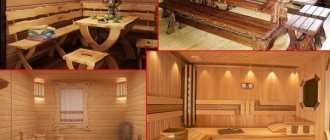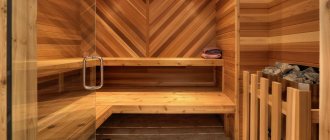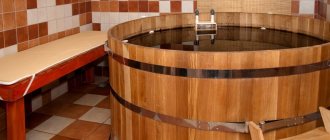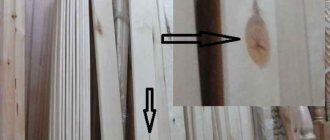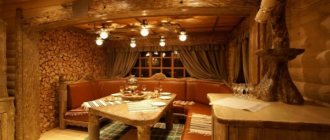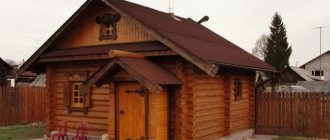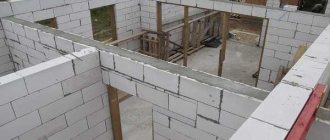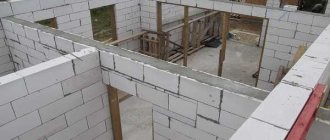What lumber would be preferable to make bath shelves from?
We will try to answer this question without substituting or replacing the answer with reasoning about how bath “furniture” should be properly arranged. The fact is that we have already devoted an entire article to a story about what size —in height and width—should be the shelves for a Russian and a Finnish bathhouse, describing in detail all the differences associated with the peculiarities of national bathhouses. Therefore, for those for whom it is now more important to decide not on the dimensions of the boards, but on the dimensions of the product itself , we recommend following the link.
Preliminary planning and calculations
Calculations and a basic design are prerequisites for a successful result. Draw a preliminary small plan of the room, put down dimensions, mark the location of equipment, window and door openings.
Scheme and principles of placement of regiments
Therefore, owners of steam rooms with windows who decide to independently manufacture comfortable shelves for a bath have a limited choice. They will be able to draw a plan for a future multi-stage structure only along walls without windows and without glazed ventilation vents. Otherwise, the placement schemes are the same for everyone. Shelves can be arranged:
- a single linear object along one wall in one, two or three rows;
- G-shaped design with numerous variations in the number of steps. Two or three along each wall, or the upper and lower benches along the long wall, and the middle one along the adjacent short one, etc.;
- two parallel structures, symmetrical or asymmetrical, installed at opposite walls of the steam room, as in a railway compartment. Or how in the same compartment there are two equal tiers of shelves.
Draw out several options from which you can choose the best. Only for competent planning and calculation of costs for the purchase of lumber, you will also need the exact dimensions of multi-stage or single-stage shelves for a bathhouse.
Dimensions of bath seats or beds
To begin with, we list the traditional sizes of places for receiving bath procedures in a lying and sitting position:
- 1.5 m of length is needed in order to lie on a shelf with legs bent at the knees;
- 1.8 m in length will allow the average majority not to bend their legs when lying down. But according to this parameter, everything is purely individual, sometimes 2.00 m is not enough;
- 0.4 m is the minimum width of the shelf, most often the lower one, used primarily as a stand under the feet of a bathhouse attendant wielding a broom. It will be quite comfortable to stand on such a step, and you can also sit down to refresh yourself and cool down;
- 0.6 m is the most common size for the width of a sauna bench, although not very conducive to lying down;
- The 0.9 m width will allow you to sit across the shelf with your legs tucked in, and people with any physiological characteristics will be able to lie down.
Variations are acceptable, but bath attendants do not recommend doing less than the minimum limits.
Let's figure out the height of bath furniture
In terms of height, the principles of arranging shelves in a bathhouse are radically different from standard designs. All calculations begin with determining the height of the upper bench. In order to be able to sit on it and, when waving a broom, treat the back of a lying person, and not the bath floor, the plane of the upper shelf is located at a distance of 1.10 - 1.20 m from the ceiling. There is another reference point - the level of the steam door of the heating equipment. It is up to the owner to decide whether to adhere to it.
The height of the sauna benches varies from 0.4 m to 0.6 m. A “run-up” of 20 cm will allow you to slightly raise or lower the lines of the benches in the drawing so that the steam room has the required number of steps. The main thing is that the lower tier is at least 0.3 m above the floor surface.
How to make a sauna bench
The dressing room needs a full set of furniture, including benches for sitting and resting. But in the bathhouse they have two specific functions: they are used as a lower tier or for sitting next to the shelf. It is very convenient to keep bowls and brooms on the bench.
Photo gallery: design and drawing of the product
It’s easy to make your own concave bench for a bath
The frame of a bench is easier to make than making shelves. Not the simplest, but interesting version of a bench - a design with a concave seat
Tools and materials
The tools needed are the same as for previous products. Additionally, you will need a flexible ruler to draw a curve on the seat supports. The principles of manufacturing and subsequent processing of materials are also no different.
Table: bench materials
| Name | Size, mm | Quantity |
| Pine beam for legs. | 100x100x3000 | 1 PC. |
| Pine board for sitting. | 25x100x3000 | 5 pieces. |
| Self-tapping screws for wood. | 50 | 1 kg |
| Wooden plugs for self-tapping screws. | Diameter 10 | At least 10 pcs. |
| Impregnation for wood is waterproof and pyroprotective, oil-based, ecological. | According to the specified consumption per m2 | |
Manufacturing procedure
We begin work immediately after preparing all materials.
- We cut boards and timber according to the dimensions indicated in the drawing.
- We draw a curve on all the supports under the seat: we step back on them from the bottom edge of the board 75 mm from the edge and 45 mm in the middle, connect the curve using a flexible plastic ruler.
Marking the support is done using a flexible ruler - We cut out the supports with a jigsaw.
- We remove chamfers on the boards intended for the seat, lower drawers and beams.
- We process all the parts with a grinding wheel using a drill.
- Assembling the seat box. We recess all the screws.
When fastening the box parts, we recess all the screws - We insert the remaining supports into it and fix them.
The central supports are fixed with screws - We mount the boards on all six supports.
Don’t forget to drill holes to deeply recess the screw heads into the seat. We close the holes with wooden plugs. The boards are attached to the seat supports using self-tapping screws - Then we put timber legs into the resulting structure and fix it with self-tapping screws.
The timber legs are inserted into the seat box and attached to it - We strengthen them with lower drawers on four sides, recessing the screws. We make our task easier by placing a piece of wood under each drawer. The bench is ready.
Video: DIY sauna bench
What material is suitable for manufacturing
To make bathing procedures enjoyable, you need to choose the right material for the shelves. Wood used in steam rooms must have a number of qualities:
- Heat resistance, resistance to sudden transitions from cold to extreme heat. The tree should not be subject to deformation or destruction.
- Moisture resistance.
- Low thermal conductivity so that the flooring does not overheat and you can lie on it.
- No defects or damage on the boards. The lumber must be of good quality. The presence of resinous inclusions, which will become a problem when heating the room, is unacceptable.
Different types of trees are used to make shelves:
- Linden is light, easy to process, durable, and does not lose its smoothness. It is recommended to use well-dried linden boards - they do not darken over time. When heated, the linden shelves will release a relaxing aroma.
- Aspen – has healing properties, purifies the air in the steam room. An aspen shelf will last for many years without losing its appearance and will not require special care. The cost of aspen material is minimal, but it has a drawback: the fibers inside the boards can begin to rot. Therefore, you need to dry the bath well from time to time.
- Poplar is a soft, lightweight wood that can be processed. It also has decorative qualities. Such shelves will become an expressive addition to the interior of the bathhouse.
- Alder has proven itself well in extreme conditions. This wood has the lowest thermal conductivity. An additional plus is the uniform structure of the wood and the non-darkening shade.
- African oak (abashi) is a durable and beautiful tree that can withstand heavy loads and does not develop defects. Such shelves will not only last for many years without losing their appearance, but will also delight those relaxing in the bathhouse with the pleasant aroma that comes from the wood when heated.
- Maple is an inexpensive and very durable material that is easy to process. Maple shelves are wear-resistant and will not dry out. The tree has a fiber-free structure.
Why is bath furniture always made of wood?
The Russian bathhouse has always been built of wood, but now, with a wide variety of materials, it can be anything: brick, foam concrete, expanded clay blocks. The main thing is to ensure good thermal insulation and resistance to moisture. Doors and a font can be made of glass, plastic, concrete, but the furniture can only be made of wood. Because only this material can withstand long changes in temperature and humidity without burning the body.
A bathhouse can be built from a variety of materials, but the furniture for it must be wooden
Types of bath furniture
Depending on the place of use, there are different types of furniture:
- for the steam room - a system of shelves and benches;
A properly organized steam room space is a system of shelves and benches - for the dressing room and rest room - benches, tables, stools, armchairs, sofas.
A table and a bench with stools are the necessary furniture for the dressing room
Choosing wood for bath furniture
The material should be easy to process and maintain, moisture-resistant, not prone to cracking, and not emitting resin. And if coniferous wood is suitable for the walls and doors of a Russian steam room, in which the temperature is lower than in a sauna, then only hardwood is suitable for benches and shelves:
- rare exotic wood species - Malaysian red meranti, African oak, Canadian hemlock fir, South American cedrella, bamboo, West African ofram - are suitable for baths, but are rare and expensive, so they are most often used for headrests;
- Linden is ideal for damp and hot rooms - a light, elastic, very fragrant material, releases phytohormones, promotes strong sweating, is easy to process, heats up little and does not darken from long-term use;
- aspen - soft and pliable to work, smells pleasantly of something bitter when exposed to high temperatures, is resistant to moisture, does not deform, but has a fibrous structure that cannot be smoothed with any plane;
- birch is a tree that emits a lot of useful substances, but is inconvenient to process, does not resist moisture well and cracks, and also heats up and cools slowly, and darkens with long-term use;
- oak is dense and durable, does not warp or crack, perfectly resists humidity and temperature, but is expensive and gets very hot;
- maple is a dense wood, but needs to dry for a long time before use;
- poplar is easy to process, beautiful and inexpensive, but short-lived;
- cedar is a high-quality and useful type of wood, when heated it oozes little resin due to its high density, is highly resistant to mold, but expensive and difficult to process;
- pine is a beautiful soft, durable coniferous tree; in the bathhouse it smells pleasantly of essential oil, but when heated it releases resin, although not in such quantities as larch and cedar, so it is only suitable for furniture for the dressing room and rest room.
Photo gallery: materials for bath furniture
Pine exudes resin, so it is not advisable to make shelves from it
Cedar oozes a little resin when heated, but with good processing it can be used to make furniture for a bathhouse, for example, headrests. Poplar wood is easy to process, but short-lived. Maple needs high-quality and long-term drying before use.
Oak furniture does not warp or crack, but gets very hot
Birch darkens with prolonged use
Aspen is resistant to moisture and temperature changes, does not deform
Linden is the best material for furniture that will be used in damp and hot areas
Meranti - wood from deciduous trees from the Shorea genus - beautiful, high-quality, but expensive material
How to make shelves in a steam room. Installation Guide
Based not only on practicality, but also on considerations of universal installation of shelves, for the installation example we will use as few parts as possible of different sizes and types, i.e. so that their size is universal. Therefore, we will focus on a design in which the maximum number of meter-long bar blanks is possible. Universal size. The height of the top shelf (from the floor level) is 1 meter, the total width of all shelves including the top 60 cm and the bottom 40 cm is also 1 meter. The height of the first, low shelf is 50 cm, which is half a meter block. Almost all parts can be made from meter-long pieces. To construct the shelves we will use a 50mm*70mm block. With such dimensions, the distance to the ceiling from the top shelf is 125 cm, which is even very good for a steam room - there is room to wave a broom over your head.
In order to more clearly visualize the structure of the shelves in the figure, similar parts of the same type are depicted below in the same color: • green - length 60 cm; • blue – length 100 cm; • yellow – length 100 cm; • red - length 50 cm, 16 pieces of meter bars, 4 pieces of bars 50 cm long, 6 pieces of bars 60 cm long. In total, 22 meters of bars are needed for the frame.
The method of cutting the connections between the frame bars of the shelves is also of the same type and makes it possible to mass-produce these parts. For ease of perception of the picture, the parts that play the role of backs are not shown.
For installation, an ordinary planed spruce block is used. Before installation, it is recommended to lower the lower ends of the bars that will stand on the floor into a container with an antiseptic no deeper than 1 cm for 1 minute. This is the most vulnerable point of the shelf frame
This is especially important in case of leaky wet floors.
The shelves themselves are usually made of low-density hardwood. The most affordable wood is linden. But in comparison with traditional building materials, the price of high-quality raw materials is much higher.
Those who like to have a good steam bath believe that the size of the shelf should be such that you can lie down with your arm extended forward and the width should be 80-90 cm. This size can be achieved in small steam rooms only if you do not use the bottom shelf for the seat, but only as a step. Or is it better then not to make a step at all, but to make the height of the top shelf such that it would be convenient for the one who carries out the procedures with a broom. This applies more to the professional use of steam rooms.
If you noticed, the frame is made in such a way that it is in no way attached to the frame. This is due to the fact that the log house shrinks and the structure may become deformed or prevent normal shrinkage. The greatest danger is the through fastening of the frame to the crowns through a layer of lining and foil wool for decorative cladding of the steam room. They are most easily destroyed when the log house moves.
Shape of shelves for bath accessories
In this case, we mean by “shape” design features. Inside the quadrangular room, shelves in the bathhouse for shampoos can be placed either along the wall or in the very corner. In addition, they can vary in support or fastening, because they can not only be screwed to the wall, but hung from the ceiling or made into a floor version (although this is already a bookcase).
Wall mounted soap
Wall-mounted options differ in the presence or absence of a support that evenly distributes the load across the entire width of the shelf. Typically, the support is a bracket - a triangle, one side of which is attached to the wall, the other supports the shelf, and the third transfers the load from the shelf to the wall and imparts rigidity to the structure.
Shelf for shampoos in the bathhouse on brackets
This is a reliable, time-tested option, but for our case it is not so important, because we are talking about shelves in the bathhouse for soap and shampoo, and they have little weight, so the bracket can be omitted, or made decorative.
ON A NOTE! Shelves on brackets are optimal if the shelf itself or the objects standing on it are heavy.
In addition to brackets, various fasteners are used to hang a wall shelf. They can be visible or hidden. You can learn more about fastenings from this article.
Wall mounted for accessories
This type involves placement along the wall and fastening directly to it. Fasteners (by the way, this applies not only to wall-mounted shelves, but also to corner shelves) can be very different: from traditional corners and eyes to different types of hidden fastening (on hidden hinges, on metal pins or wooden pins, on eccentrics).
This video shows a hidden mount for mensolo holders:
Watch this video on YouTube
And here - for eccentrics:
Watch this video on YouTube
It is important to estimate in advance the weight that will be required for the mount. It includes the weight of the shelf itself, as well as future items that you intend to place on it
IMPORTANT! Please check the “endurance” (maximum load) of the fastening elements when purchasing. The most important shelves are best made on brackets - triangular supports, the vertical of which is attached directly to the wall, and the corner piece transfers the load from the board to the wall across the entire width of the shelf
The most important shelves are best made on brackets - triangular supports, the vertical of which is attached directly to the wall, and the corner piece transfers the load from the board to the wall across the entire width of the shelf.
If we are talking about a shelf for accessories, then the weight of it with all the items will be small, and the fastening can be done in any convenient way.
Hanging
The number of fastenings can be reduced if the multi-storey wall shelf is made suspended. Thick rope, cable or metal cable are often used as suspensions. But you can also hang it on leather strips.
The hangers can be attached directly to the wall using an anchor or dowel, or they can be attached to brackets located above. The third option is ceiling mounting.
Materials and choice from them
The board for the shelf in the bathhouse may not be made of any type of wood. First of all, you need to carefully examine it.
Preparing shelves for use in the mode of differences in high and low temperature conditions. Plus increased humidity, which is tolerated differently by everyone. Not everyone can handle such extreme conditions.
There are three main properties that a wood species must have:
- The first is ignition stability. So the number of compounds with resinous components should be minimal. In addition, the tree should not “succumb” to humidity and temperature;
- The second property is related to the comfort that must accompany those relaxing in the steam room. To do this, the material must have high thermal conductivity;
- The density of the rock and its lack of layering will eliminate the occurrence of splinters and splinters.
Trees that have all these properties can be quickly counted. These include:
- Aspen species;
- Larch;
- Linden.
Under no circumstances should coniferous species be used for these purposes without pre-treatment. The resins present in them can cause thermal burns.
Choosing material
Fortunately, now is not the heyday of Soviet perestroika and the choice of both finished products and materials for their manufacture is quite large. Let's evaluate the possibilities and, so to speak, prospects.
Plastic products
The most affordable and most practical material in the finished product. The world of plastics and polymers is phenomenally diverse. As a rule, you can make only the simplest plastic shelves for a bathhouse with your own hands, taking as a basis planes with a minimum number of roundings, decor and other difficult-to-reproduce elements.
Industrial products are made by injection molding, which in the vast majority of cases cannot be reproduced at home. An interesting material in this regard is acrylate, better known in wide circles as plexiglass. Outwardly very similar to ordinary glass, it is much more resistant to mechanical destruction, although at the same time it is scratched more easily. It is more difficult to work with than other structural plastics, but easier than with glass.
Glass shelves
They look appropriate in oriental baths - hammams and modern saunas, made in the currently fashionable interior style - minimalism. You can make your own glass shelves for a bathhouse in the simplest geometric shapes, but you can decorate the product with purchased fittings. Copper, bronze, brass parts, stainless steel and nickel products look especially advantageous. The main disadvantage of glass, in addition to the fact that it is difficult and unpredictable to process, is the increased risk of injury in the event of its destruction. Naturally, it is necessary to give preference to shelves made of thick tempered glass, which, with a strong impact, breaks into many cubes according to the “stalinite” principle of automobile glass, but processing such material is far from easy.
Hardware
Let's be honest, metal has not found proper application in bathhouse use. The only exceptions are stainless steel and products made of non-ferrous metals, primarily bronze and copper. How convenient and practical they will be is the question.
This is where metal certainly rules, in the world of fittings: holders, brackets, hooks, racks, fences, spacers, fastening hardware
However, when choosing them, you should pay attention to corrosion resistance in a humid environment. Products made of ferrous metal must, at a minimum, have a protective coating
Well, of course, we shouldn’t forget about the high heat capacity of metals; therefore, rooms with very high temperatures are by no means their element.
Wooden shelves
Wood is the most common, convenient and practical material in a traditional bathhouse. Why are they so good and attractive:
- Firstly, wood is available, both in terms of price and, thank God, also in terms of choice;
- Easily processed with a tool from the arsenal of an average home craftsman;
- Products made from it, subject to some simple rules, are quite practical and quite durable;
- In the event of a breakdown, their repair is not particularly difficult;
- Fits perfectly into any classic interior, with the possible exception of the oriental one;
Let's face it, do-it-yourself wooden shelves in a bathhouse are the most common and commonplace occurrence. From here - a small master class.
Dimensions and shape
All kinds of shelves in the bathhouse
The lower shelves are made in the form of a bench with a seat, a back, four legs and reinforcing crossbars. Portable benches with two supports and without a back are unstable and quickly fail. The seat boards must be secured at intervals necessary for water drainage and ventilation.
The height of the first level is made 35 - 50 cm, the second shelf is placed so that when sitting on it, a person rests his feet on the previous floor. Lying down, the visitor must stretch his legs along the length, so the minimum size is 1 m 50 cm, but if possible they do more.
The width for sitting in a Russian bath is 50–60 cm; in a dry sitting sauna it is 40–50 cm. For lying down, the width according to the instructions is taken so that a person in a supine position can freely place his arms along the body. Usually a width of 90 cm is sufficient.
Scheme
It's time to get down to specifics. So, what exactly does any shelf consist of? There are two main structural elements in it: the frame and the flooring.
Above it was said about the fundamental difference between the width of the shelves and the number of tiers for the Russian and Finnish steam baths, so we will give diagrams of the regiments in the bathhouse for each case. Since the only difference is in the frame, we will describe the flooring separately - it is the same for both types.
An important point about any frame: among experienced bathhouse attendants there is still debate about whether the frame can be attached directly to the wall or must it be free-standing?
The main argument of those who are in favor of a free-standing frame is that when mounted on a wall, the joint soon begins to rot.
However, we know of a compromise option in which the mounting on the wall is done with a gap - you install bushings, for example, ceramic ones, which are used for the same separation of thermal insulation slabs from the wall.
Frame in a Finnish sauna
The frame of the regiments in the Finnish bathhouse looks something like this:
As you can see, in this case it is proposed to start from the specific height of the ceiling in the steam room, because the countdown is carried out precisely from it. At the same time, it is precisely this height that suggests a very common mixed form - this is when both steam is generated and the temperature is high, as in a dry-air bath.
CAREFULLY! The combination of high temperature and humidity is difficult for the human cardiovascular system!
In general, the layout of shelves in a bathhouse can be easily distinguished precisely by their height and width. The height of the step, if it is intended for sitting, will be about 45 cm. And for the approach of the steamer, 70-90 cm are needed. Therefore, either one of the steps will be narrow/folding/portable, or this is a sauna option, not intended for one person was lying, and the other was floating.
Another characteristic feature of a sauna shelf in a bathhouse is that the frame is covered in height with clapboard. This is done because the Finns do not need to leave space for the soaring person to freely position his legs - his feet with their toes go slightly inside, under the shelves, while achieving the very correct vertical position of the soaring body.
BY THE WAY! It is a common belief that if you cover the height of the shelves with clapboard, this will significantly reduce the volume of the steam room that the stove heats (and accordingly, increase its power). There is truth in this, but only in the case of hermetically sealing the space under the shelves. And this is bad - how to ventilate? And if you ventilate, then there will be no “volume reduction”.
Frame
Here there is one interesting point: two-tier Russian shelves can look like three-tier ones! This is due to the deceptive footstool that is placed near the high shelf. This bench can be mobile or stationary. But it’s still better to have a mobile one.
An ordinary two-tier shelf consists of an upper shelf, intended for hovering, and a lower one, on which the hovering person stands with his feet. At other times, the lower one can be used as a seat.
Below we present several more options for shelves in the bathhouse, showing their possible location (having one stationary shelf and two sliding ones, or all three sliding ones, we get the following options):
Flooring
Let's talk briefly about flooring. Despite the fact that the most common option is a processed strip laid along or across the long side of the seat with a smoothed edge and a gap of 1 to 5 cm between the elements, you can find options without gaps at all or made from boards with irregular geometry (unedged sanded board or croaker).
A log shelf looks exotic, but how long will it take to dry?
ADVICE! Whatever guides you when choosing a flooring design, take into account the fact that you need to dry it after each procedure. And the gaps are made not for the sake of beauty, but for the sake of ventilation and speeding up the drying process.
Railing
A useful, although not obligatory, element for regiments. In general, the railings in the steam room are used in two cases: as a fence for the stove - so that visitors do not accidentally approach it at a dangerous distance and touch it. This applies to steam rooms with metal stoves without brick or stone lining.
The second use of railings is to equip shelves. They create additional convenience for steamers when ascending and descending, and also make staying on the top shelf safer. And also, if they are placed parallel to the shelf, then while sitting on the shelf you can put your feet on them, this adds convenience and your feet receive more warm air and steam.
Such railings look something like this:
Finishing and Coating Tips
Fans of an ecological lifestyle claim that treating wooden surfaces in a bathhouse is not only unnecessary, but also harmful: impregnation, paints and varnishes, when heated, give off a strong chemical odor and emit harmful volatile substances. This is true if you use ordinary means. But if you leave the wood in its original form, after some time the furniture, headrests, wall and ceiling cladding will darken, become porous, dirt will become embedded in them, and fungus will grow in micropores and cracks.
In village bathhouses, wood used to be looked after in the same way as the floors in a hut: they regularly scraped it with a knife, removing the top, dirty layer. But this is a very labor-intensive task that does not give full results.
For a modern busy person who does not want to use impregnation, there are only two options:
- rarely go to the bathhouse and dry it well, which will delay the above processes, but will not cancel them;
- Every two or three years, completely change the upholstery of furniture, walls and ceilings.
If you don’t want to treat wood with special impregnations, every two to three years you will have to completely change the upholstery of furniture, walls and ceilings
Application of impregnations
The only complete solution is to use modern compounds at the construction stage that can withstand high temperatures and humidity without harm to humans, and protect against fungus and rot. They are different. Those that are suitable for the ceiling cannot always be used for furniture.
Ceiling impregnations are not always suitable for treating bath furniture
There are many such products produced by manufacturers of varnishes and paints - Senezh, Rogneda, Dulux, Tikkurila, etc. They come in two types: for surfaces that we do not touch with our bodies (ceiling) and others. The requirements for the latter are much higher, since they should not form a scalding varnish film. For bath furniture, products with water-repellent natural substances (paraffin, wax, oil) are used, which perfectly protect the furniture and are harmless to humans.
Table: purpose and features of wood impregnations
| Name | Manufacturer | The basis | View | Purpose |
| Supi Laudesuoja | Tikkurila | Oil | Oil | Furniture, walls. |
| Sauna Natura | Teknos | Oil | Jelly-like consistency | Furniture, walls. |
| Eurotex Sauna | "Rogneda" | Oil | Aqualak | Furniture, walls. |
| Supi Saunavaha | Tikkurila | Oil | Universal composition | Furniture, ceiling, walls, doors, floor. |
| Dulux Celco Sauna | Akzo Nobel, Dulux | Varnish | Protective varnish | Ceiling, doors, floor. |
| Elcon Sauna | Elcon | Silicone | Impregnation | Ceiling, doors, floor. |
Specifics of applying protective compounds
The chosen product must be used correctly.
- The first application is carried out immediately after manufacturing the furniture on a dry and clean surface or even on wooden blanks.
- The product should be evenly distributed with a sponge, soft cloth or brush. Due to the thick consistency, a spray gun will not work.
- After the first layer has dried, those places that will be subject to maximum load - seats, headrests, walls in the shelf area - need to be treated again.
- Then heat the bathhouse. When heated, excess impregnation will certainly come out: wipe it off with rags.
The product must be evenly distributed over wooden surfaces using a sponge, soft cloth or brush.
Features of the Finnish sauna and Russian bath
Before you start arranging the shelf, you need to decide on the type of steam room. Each type has individual characteristics.
Table 1. Differences between Finnish sauna and Russian bath
| Type | Characteristic |
| Finnish | Due to the fact that humidity does not exceed 20%, the air in the steam room is dry. Temperature ranges from 90 to 100°C. This microclimate is not suitable for people susceptible to respiratory diseases. Steam negatively affects the mucous membranes and causes coughing. |
| Russian | The humidity level is close to natural, reaching 70%, and the temperature ranges from 50 to 80°C. Good thermal conductivity of moist air contributes to the heating of the human body and the release of toxins. |
Unlike a sauna, being in a bathhouse does not lead to tachycardia
Key differences:
- Thermal sensations from heated air. In the Finnish steam room, steam has a scalding effect. This occurs due to low humidity levels. In Russian steam rooms the air is light and does not provoke a burning sensation.
- Location of stones. In the sauna they are placed in an open space. In the bathhouse, rock fragments are placed in closed stoves, which are regularly opened for watering. This helps to enhance the steam.
Stones for stoves
- Availability of a swimming pool. A sharp change from hot steam to cold water hardens the body. Water tanks are typical for Finnish establishments. They are less common in Russians, since traditionally baths were built near bodies of water. Often in domestic steam rooms a wooden font is installed.
- Broom. A typical attribute of a Russian steam room. This bath accessory is made of oak, cedar or birch. Hitting the body with a broom soaked in hot water increases sweating and accelerates the blood. It is not used in the sauna because it does not have the desired effect at low humidity.
Specifics of the Russian steam room
It is customary to lie in the bathhouse. This nuance is of decisive importance during the construction of the regiment. In addition, the percentage of moisture present is important. High humidity levels slow down the movement of air masses
This factor must be taken into account when arranging wooden sun loungers.
General recommendations:
- Large gap between blanks for improved air conditioning.
- A slight inclination of the sunbeds to organize water drainage.
- Removable or non-sewn sides to optimize cleaning.
- Wide distance between the shelf and the wall to prevent water from entering the frame.
- When calculating the height of the upper tier, the mandatory distance of 1 m between the head of the soaring person and the ceiling is taken into account. This interval is necessary for the bathhouse attendant to wave his hand with a broom without hindrance.
- Since it is preferable to undergo procedures while lying down, the beds must be at least 2.2 m in length and 0.6 m in width.
In a traditional bathhouse, one- or two-tier shelves are installed.
Standard two-tier shelves
Specifics of the Finnish steam room
Externally, the domestic and Finnish doubles are similar. However, different temperature conditions and humidity levels caused a number of differences.
Features of sauna arrangement:
- Material. For the interior decoration of the bathhouse, exclusively natural wood is used. Artificial raw materials do not have such a successful combination of positive properties. When building a sauna, in addition to wood, other materials are used to improve the quality of sanitary cleaning and improve hydro- and thermal insulation.
- Size. Due to the fact that the air in a Finnish steam room must warm up quickly, the sauna is slightly smaller than the bathhouse. In order to optimize the organization of space, shelves are installed around the entire perimeter of the room. Exceptions are walls with a heater and a door.
- Seating arrangement. Since clients in European steam rooms prefer to sit, the distance between the wooden lounger and the ceiling should be greater. The width of the benches is not important.
The small dimensions of the sauna mean that no more than 3 people can be in it at the same time.
The backs of the seats in the sauna are covered with boards
Shapes and sizes of the shelf in the steam room of the bath
The choice of shape and configuration of the shelf is influenced by the area of the steam room and its height. Typically, decking is installed along one or two walls, less often - three. L- and U-shaped configurations are common, the location of the flooring may vary.
The simplest and most popular shape of bath shelves is considered rectangular. Such structures do not require large consumption of lumber during production and can be manufactured in any size.
The size of the shelves in the bathhouse is influenced by the dimensions of the room and the average height of those who will visit a particular steam room. Typically, the height of the steam room is about 210 cm. Single shelves or the middle bed of a multi-tiered structure should be placed at the height of the thumb of the lowered hand.
The standard sizes of bath shelves are:
- Length – from 150 cm (this is how much space is occupied by a person with his legs bent). Can be increased to 1.8-2.2 m, if space allows.
- Shelf width – range for the lower levels is 40-60 cm, 60-95 cm for the upper ones.
- The distance from the top flooring to the ceiling is from 120 cm.
- The lower lounger is placed 20-30 cm above the floor - this is necessary for normal ventilation.
- The average height of each tier is selected from the range of 40-60 cm, taking into account the height of the steam room.
Each of the forms can be either stationary or collapsible. The latter option greatly facilitates the operation of the shelves: the flooring is removable, and the frame is securely fixed.
Stepped
The most common type of bath shelves is stepped. The benches are attached to one wall so that the upper tier is adjacent to the surface, and the lower ones have an extension (like a staircase). Most often the design is two- or three-tier. Those who like to steam at very high temperatures occupy the top shelves.
Such benches in a classic bath are installed on two tiers. The height of the shelves in a Russian bathhouse is selected on the basis that the upper level is located low enough so that those lying on it do not rest against the ceiling.
L-shaped
Corner shelves are no less popular in the bathhouse. Structurally they are performed:
- Like a staircase, shifting each tier relative to the top (this type will take up more space).
- In a checkerboard pattern - the shelves are alternately adjacent to adjacent walls.
Corner models are suitable for small steam rooms where you need to rationally manage the available space. Arranged in an L shape, they take up less space and can accommodate more people than a regular straight bench.
Coupe
Compartment shelves (folding) are a good way to save space in a small steam room. The folding flooring is usually located on the top tier; as needed, it is simply raised to the wall.
The shelf in the steam room must be wide so that it is comfortable to lie on. Therefore, the ability to temporarily remove or add at least one bench will help accommodate more people with greater comfort.
Types and designs
There are several popular types of canopies: The first of them is considered the most common.
- These are ordinary shelves.
- These are ordinary benches, both in small steam rooms and in large spacious rooms;
- The popularity of beds is somewhat lower, although they can be found in various bathhouses;
- Finally, a sun lounger. It is no different from its “beach” counterpart. It can be easily adapted as a bed or chair.
Thanks to this functionality, their presence is very appropriate, but is not traditional for the interior decoration of a Russian bathhouse.
When decorating a steam room in the style of Russian traditions, do not forget that there is no need to decorate the bed with decorative elements, which can also cause injury. Everything should be as simple as possible.
A small selection of configurations indicates a small space in the bathhouse. Only in this case it warms up quickly and does not require a large amount of fuel resources.
Therefore, an ordinary rectangle best satisfies the needs of craftsmen.
